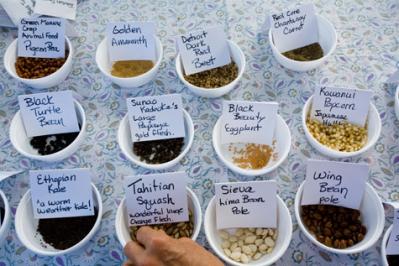
This month as I prepare my garden for early spring crops, I’m REALLY interested in learning to grow potatoes. I’m hoping to start soon since they’re a cold weather crop. We’ll see if I can make it before it gets too warm. As part of my plan, I’ll be researching different ways to grow potatoes and I’ll share what I find. This is what I know so far, you can set potato on window sill and it will sprout. You cut the sprout with enough potato and plant it. This comes from a brief conversation this past weekend with Farmer Deb. Let’s see what else I learn for now I leave you with this…
‘GROW POTATOES IN GARBAGE CAN’ INSTRUCTIONS:
STEP 1: Turn your garbage can upside down and drill several holes in the bottom of the can. Add a few around the outside wall, 3 to 6 inches up from the bottom. It’s really important to have good drainage or your potatoes will rot in a hurry.
STEP 2: Dump about 2/3rds of your bag of potting soil in the can. Mix in 1 cup of your fertilizer and set aside.
STEP 3: For your seed potatoes, small ones can be planted whole. The larger potatoes should be cut up into pieces with no less then 3 “eyes” per piece (“eyes” being those brown dimples that the roots will grow out of). Let your potatoes dry out on the cut side before you plant them
STEP 4: Once your cut potatoes have cured, plant them in your can 5 inches apart and cover with the remaining soil. You’ll only need 4 starts to a can. Set the can in an area that receives 4 to 6 hours of direct sunlight.
STEP 5: Water thoroughly and keep the soil moist but not soggy during the growing season. Don’t let the soil dry out or you’ll end up with misshaped potatoes. On the hot summer days, your potato garbage can might even need to be watered daily (you might move the can to a slightly shadier location on the hottest days).
STEP 6: As the plants start to grow in the can, mound up compost around plant stems keeping the leaves uncovered. They grow a little more, add some more compost. You’ll be able to fill up the entire can with compost by the end of the growing season. Keep it watered.
STEP 7: As the plants start to grow in the can, mound up compost around plant stems keeping the leaves uncovered. They grow a little more, add some more compost. You’ll be able to fill up the entire can with compost by the end of the growing season. Keep it watered.
SOURCE: EHOW By GreenGardenChic













Recent Comments